*This post may contain affiliate links. Read more »
As a certified freak about kichdis of all kinds, I wanted to hit you with one that’s a little different from the recipes like bisibela bath you might already know and love. Daliya is free of both lentils and rice, which is unusual for a kichdi, but it’s NOT free of extraordinary flavor, tons of yummy nourishing veggies, and the ability to be made in advance for meal prep. It’s really pretty awesome indeed!
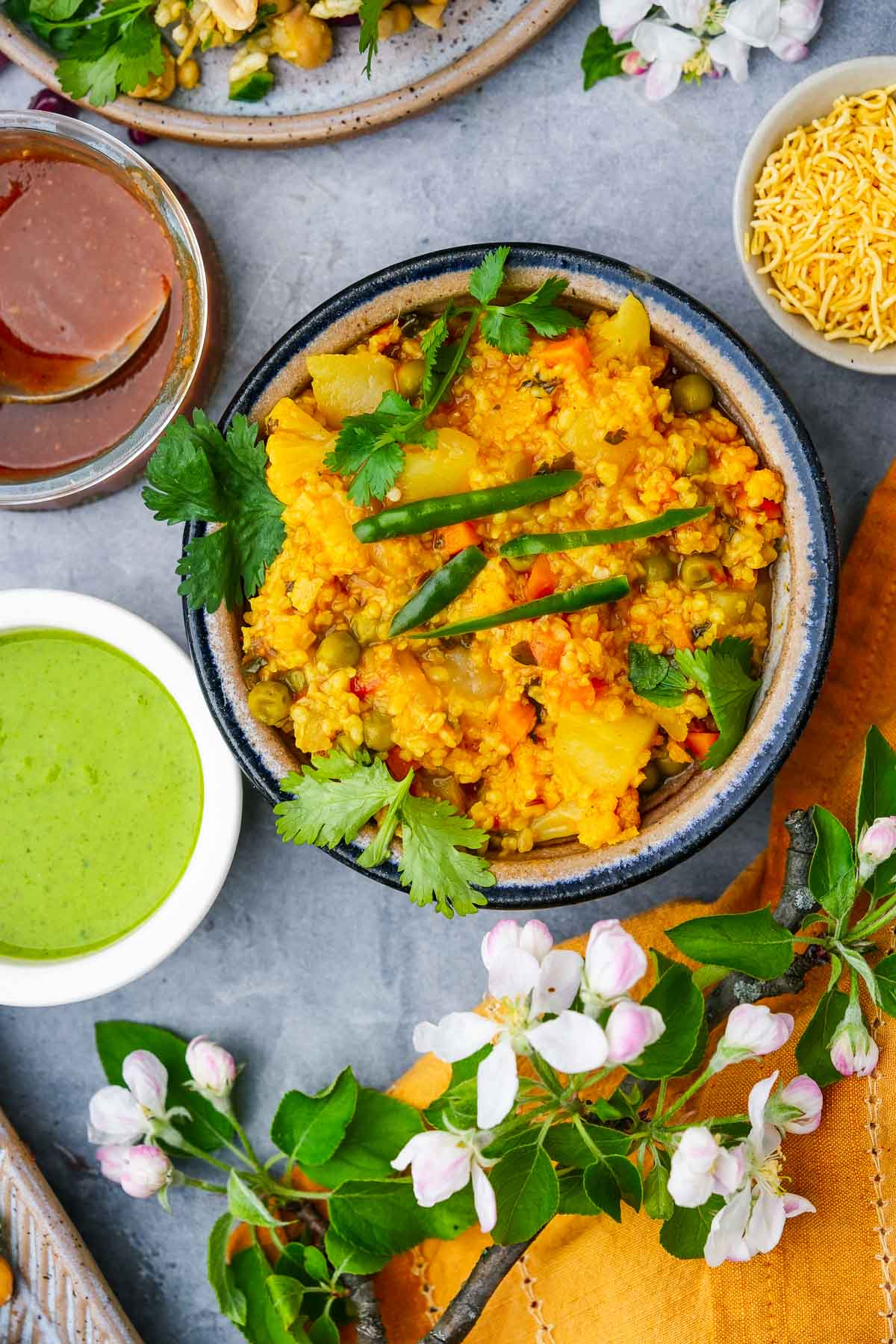

Enter your email & I'll send it to your inbox. Plus, get great new recipes from me every week!
By submitting this form, you consent to receive emails from Cinnamon Snail.
🙋♂️Uh, why is this even considered a kichdi?!?
The word khichdi (also spelled as kichadi, khichari, khichdee AND, can you believe it, khichuri) refers to a South Asian dish that is normally made from rice and lentils cooked together, seasoned with spices. It's often considered a comfort food in India and is typically served as a simple, nourishing meal that's easy to digest. For that reason, I have seen plainer khichdis being served in Indian homes where someone is recovering from an illness and their jatarāgni (digestive fire) is weak.
The root of the word "khichdi" comes from the Sanskrit term "khicca," which simply means a dish of rice and legumes (dal, lentils, peas etc). I can’t understand why Daliya is considered a Khichdi, considering there is no darned rice or dal to be found in it. I think it must be that the final texture is similar to a khichdi. If you know, please leave a comment and enlighten me, because it’s the sort of the thing I find really fascinating.
Jump to:


Curry in a Hurry - Vegan Indian Recipe Club! 🍲💌
This 6-day program is 100% FREE. Let me help you to master plant-based Indian cooking!
Here’s what really matters about Daliya:
I spend as much time as possible in West Bengal, especially on spiritual pilgrimage to Nabadvipa, and I’ll share with you a tiny detail about the food there - folks eat a ton of rice there. One year, I visited Eka Cakra on Nityananda Trayodasi, and I remember seeing just truckloads of rice being cooked and mixed outside on gigantic tarps. For real, I am not sure I have ever seen more plain rice and veg. biryani being consumed anywhere on earth!
So what happens when you are, like sorta sick of eating nothing but rice? That’s where Daliya super-lovingly shakes things up to keep your vegan diet diverse! As long as you aren’t gluten-free, bulgur (cracked wheat) is a blessing to use instead of rice. That’s why I share bulgur pilafs like Bulgur Pilavi and salads made from the darned stuff like Kisir and Taboule!
Daliya is also quicker and more fool-proof to cook than rice. Who says fast can’t be fabulous? Not us! So, grab your spoon (or spatula), and let’s make magic happen in your kitchen tonight!
🥰Why you'll adore this recipe
✊ Vegan AF: Just like all of the vegan Indian recipes I share, this Daliya is made without harming animals (heck, not even mildly inconveniencing them). This blog is 100% about kindness to all living beings and the planet, but I guess the personal benefit that comes as a bonus is that none of the recipes contain any cholesterol.
🌡️ Consistent Cooking: With the carefully timed steps I laid out in this recipe, this Daliya comes out perfectly every time. Bulgur’s quick-cooking and forgiving nature means it's nearly impossible to mess up, and adding the veggies in a couple stages means the potatoes are nicely cooked without the cauliflower being a worldwide mush-fest.
✅ Tested and Approved Worldwide: Like all of the vegan recipes I share, it's been tested by over 350 recipe testers from all around the world before I published it on the blog!
🌶️ Ingredients for daliya khichdi
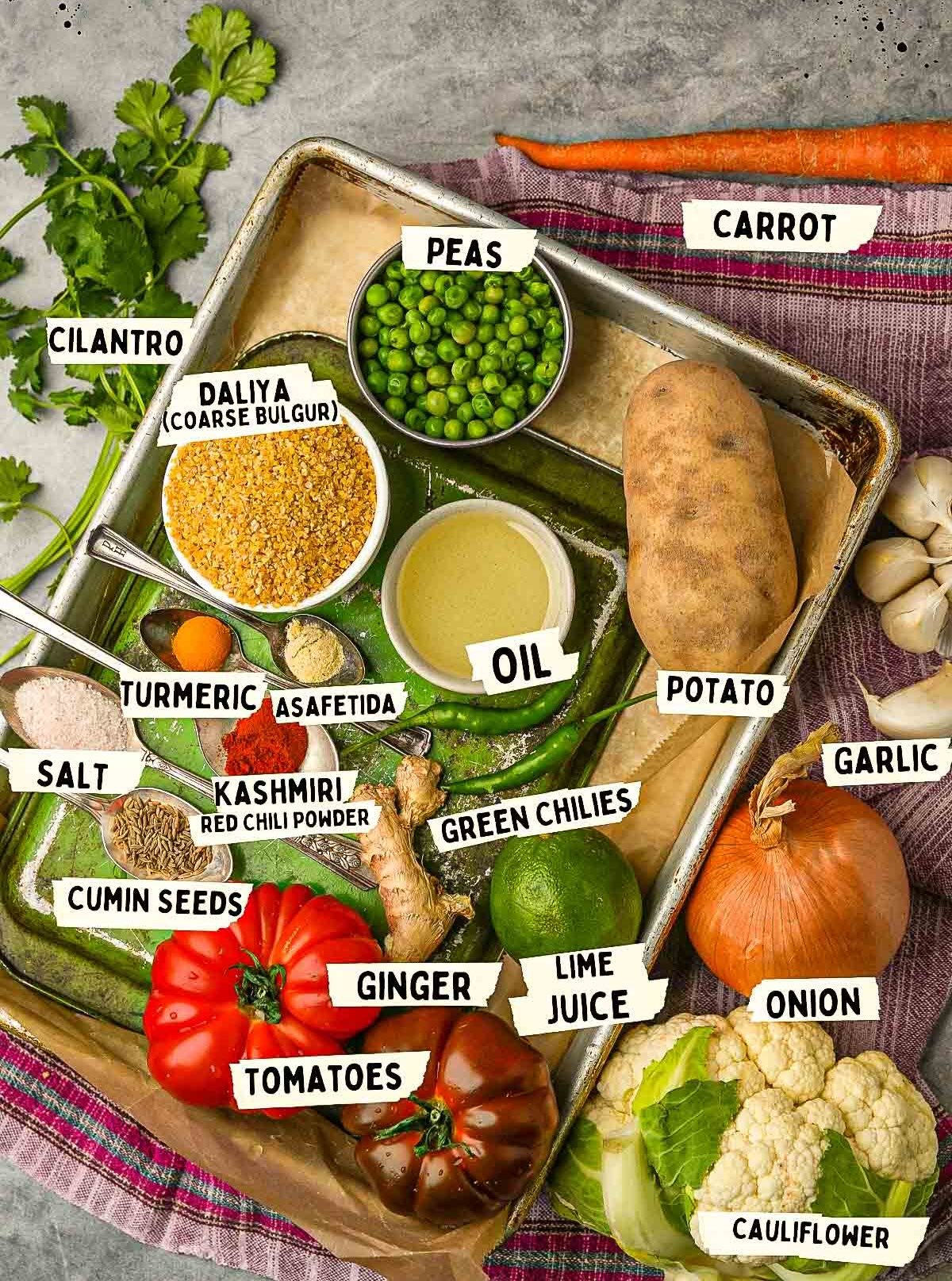
Cumin Seeds (Jeera)
Essential for their nutty, peppery flavor, cumin seeds are a staple in Middle Eastern and South Asian cooking. They add depth to the dish and also aid in digestion. If cumin seeds are unavailable, ground cumin can be used in a pinch, though it should be added later in the cooking process to prevent burning.

Get my fave cumin seeds for free!
Using this link, add the wild mountain cumin to your cart, spend at least $15 on some of the other absurdly good spices from Burlap & Barrel (they all seriously slap) and the bottle of this bangin' wild mountain cumin becomes FREE, and you will love it so much.

Kashmiri Red Chili Powder
Nothing rocks such vibrant color and tasty mild heat as Kashmiri chili powder! It's critical for the authentic look and taste of many Indian dishes like aloo papri chaat, masala phool makhana, and vegan chana masala. A mix of sweet paprika with just a little bit of cayenne mixed in can work as a substitute in this recipe.
Asafetida
Asafetida (AKA Asafetida and hing) is used in tiny quantities to add a unique flavor and aid digestion, especially in sattvic recipes where onions and garlic are not used. It's super-common in Indian vegetarian cooking, where you’ll find it in everything from massoor dal to vegan tikka masala, sukha kala chana, and parval sabji. I prefer to use powdered asafetida, because it’s so much easier to measure accurately than the dark-colored blocks of asafetida resin.
Green Chilies
Hari mirch chilies, which can be found at most Indian grocery stores, are the best to use in this recipe. They provide a sharp, fresh heat that kicks up the khichdi's overall flavor, though you can get away with using some minced jalapeño (to taste) if you can’t get the real deal. Hari Mirch makes an amazing green chili pickle, and are used in countless Indian dishes and condiments like Cilantro Mint Chutney. If you grab a whole bunch and have some left over from making this recipe, whip up a batch of lauki, or turai ki sabji next.
Daliya
Daliya, or coarse bulgur wheat, is a form of whole wheat that has been cleaned, parboiled, dried, and cracked, offering a nutty flavor and a wonderfully chewy texture. Keep in mind this is NOT the same stuff you use for making Mercimek Koftesi, Fellah Koftesi, or Cig Kofte, as they are all made with much finer bulgur. Daliya should be almost the size of grains like millet and quinoa to cook with the right texture.
*See the recipe card at the bottom of the page for exact quantities, nutritional info, and detailed cooking directions.
🤯Variations
Daliya Tadka
Not super strung out on making this “healthy” and more into making it yummy? A tadka (tempering) added at the end will do just that. You can use the tadka from my soya chaap, peerkangai kootu or arhar dal recipe. Any of those will be lovely added on top of each serving of daliya.
Daliya with Pickle
I love Indian-style pickles so darned much. Amla pickle, Avakaya Pachadi, and Gajar Ka Achar all go amazingly with this bulgur dish to make it tastier and easier to digest too!
📖 How to make Daliya
Nail this on your first shot by following these step-by-step photos with helpful tips. Or scroll down to the bottom of this page for the easy-to-print recipe card.

Step One
Start with That Sizzle:
Begin by heating your choice of oil in a Dutch oven or a thick-bottomed pot over medium heat. After about 90 seconds, when the oil is hot, add the cumin seeds. Wait for them to pop and sizzle, which will take about 30 seconds.
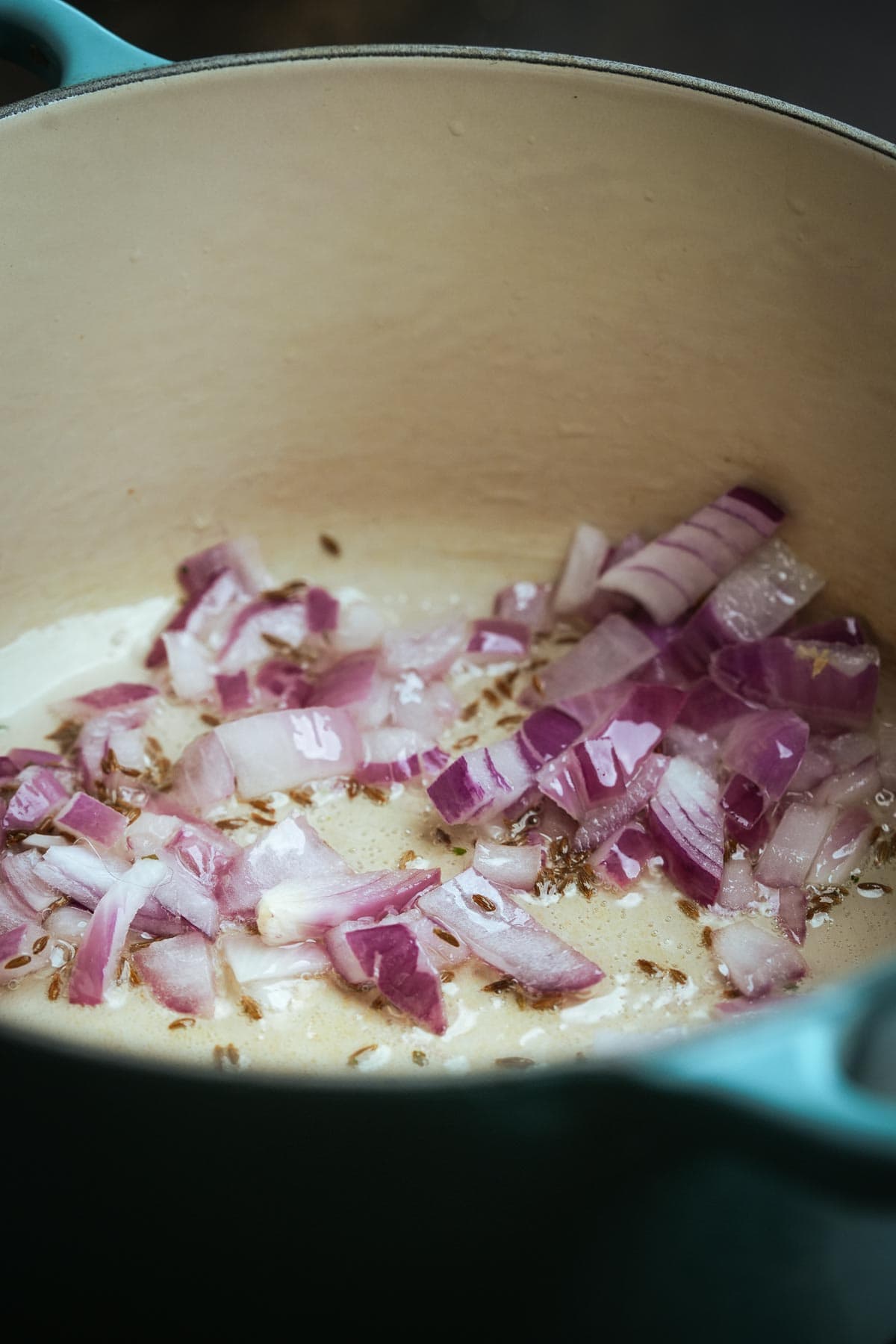
Step Two
Onions in Action:
Next, add the onions and sauté for a few minutes until they are soft and start to take on a golden color.
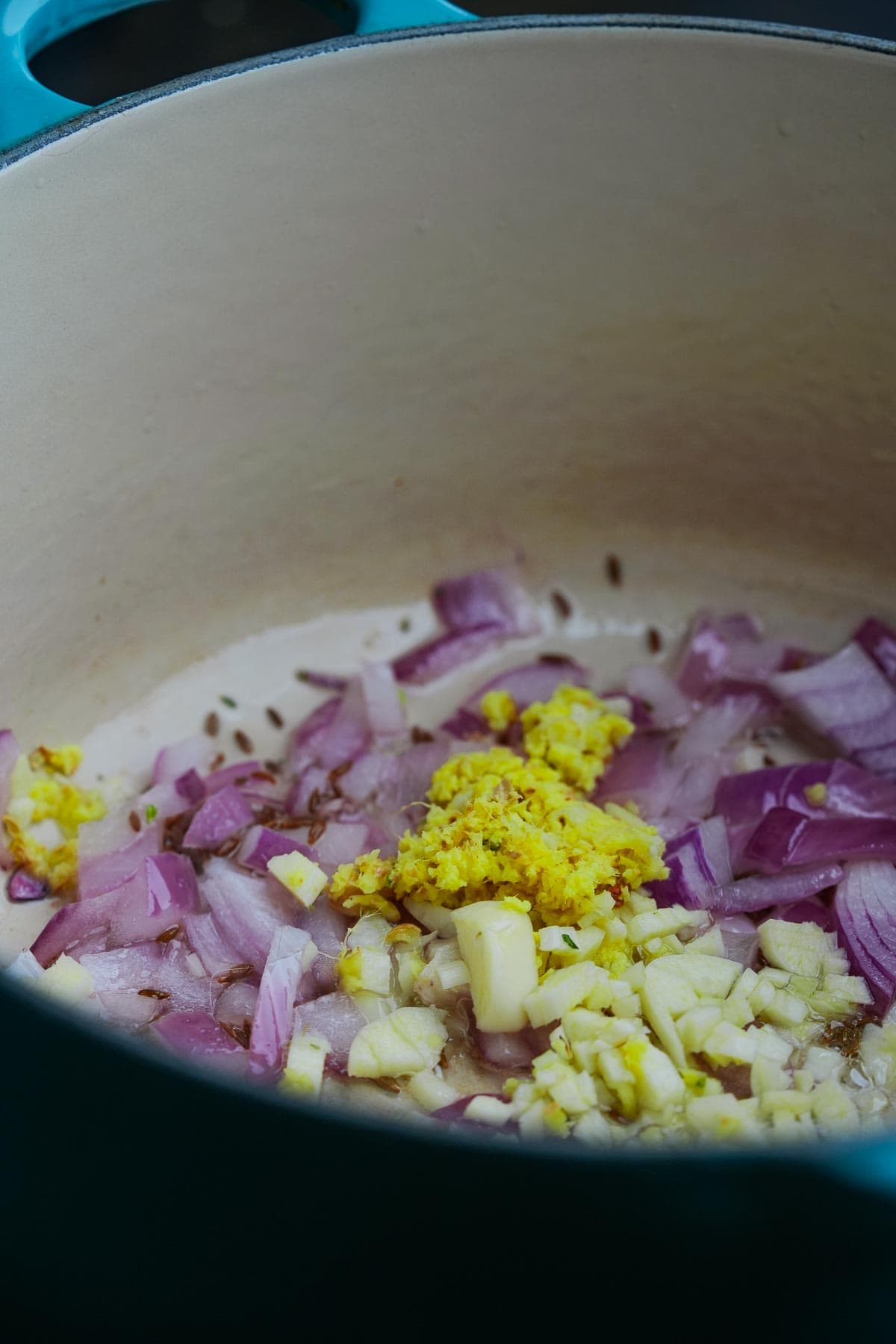
Step Three
Garlic and Ginger Magic:
Stir in the garlic, and ginger next, sautéing just for about a minute until their lovely aroma fills your kitchen.

Step Four
Veggies Galore:
It’s time to add the tomatoes, carrots, potatoes, peas, Kashmiri red chili powder, turmeric, and asafetida into the mix. Continue to sauté for a few minutes until the tomatoes begin to break down.
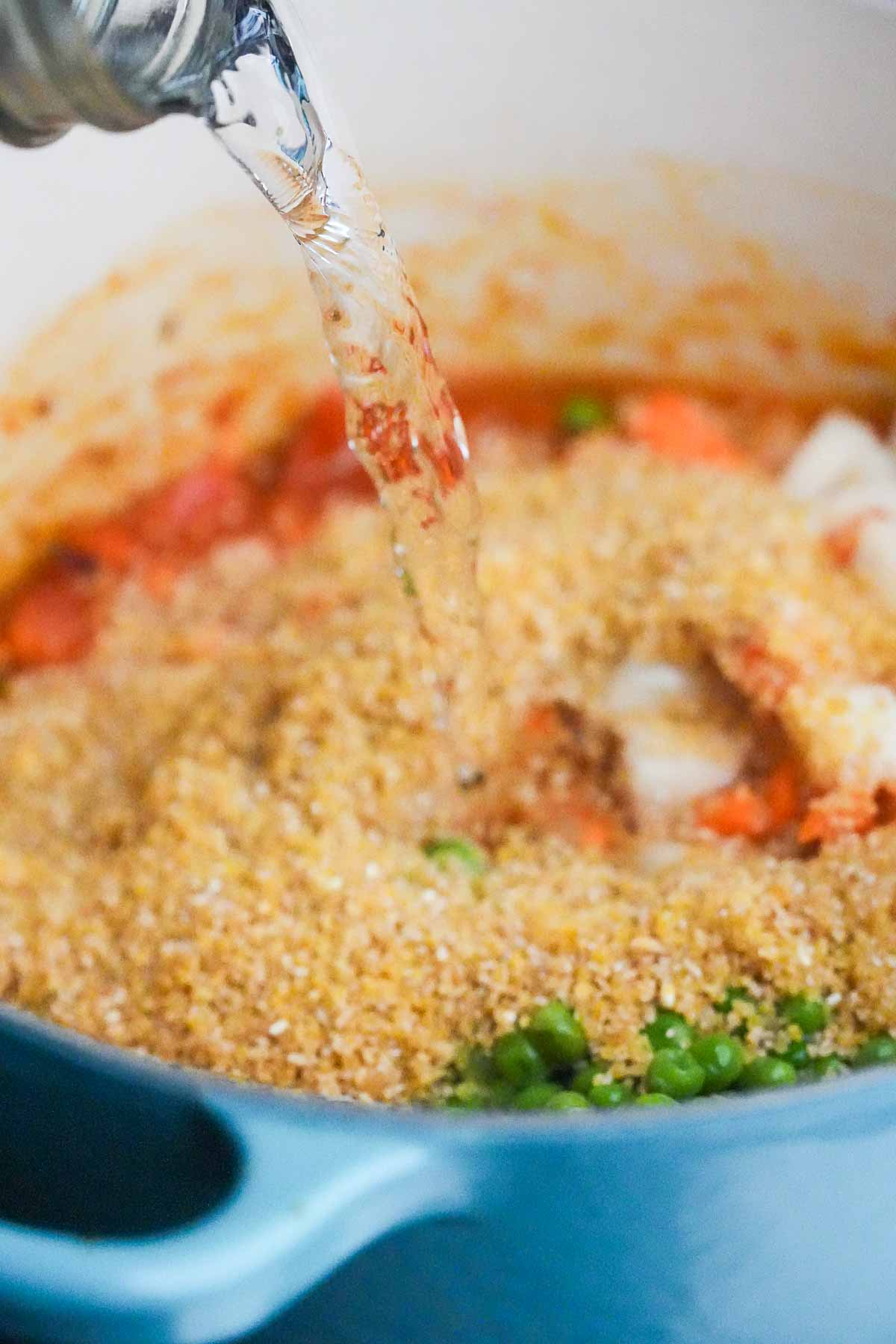
Step Five
Now Let’s Turn it Into Something:
Add the daliya (coarse bulgur) and water, stirring everything together to ensure it's well combined. Turn up the heat to bring everything to a vigorous boil.
Once boiling, lower the heat to low-medium for a gentle simmer and cover the pot.

Step Six
Cauliflower Cameo:
After ten minutes of simmering, add the cauliflower florets. Continue simmering until the vegetables and daliya are tender, which should take another ten minutes or so.

Step Seven
Final Flourishes:
Finish off by stirring in the lime juice, chopped cilantro, and salt according to your taste preference. Adjust the seasoning to your taste.

Step Eight
Garnish and Serve:
Dish out the hot daliya and garnish with fresh cilantro leaves and slivered green chilies.
💡Serving Ideas
Daliya is such a versatile dish that it practically begs to be paired with other vibrant flavors!
I love serving it with VEGGIES! Bhindi Dry (as demonstrated in my Punjabi Thali Cuisine cooking class), Jackfruit Sabji, or Saag Aloo, are all great choices for making Daliya a more nourishing meal without adding too many more carbs.
A legume like chana dal is also great, so as to make a complete protein. And of course, no proper Indian spread is complete without some good bread to scoop up all those delicious sauces, so why not whip up some Kerala Parotta or Amritsari Kulcha? The stuffed bread will soak up every last drop of flavor, ensuring not a tiny precious bit of your cooking effort goes to waste!
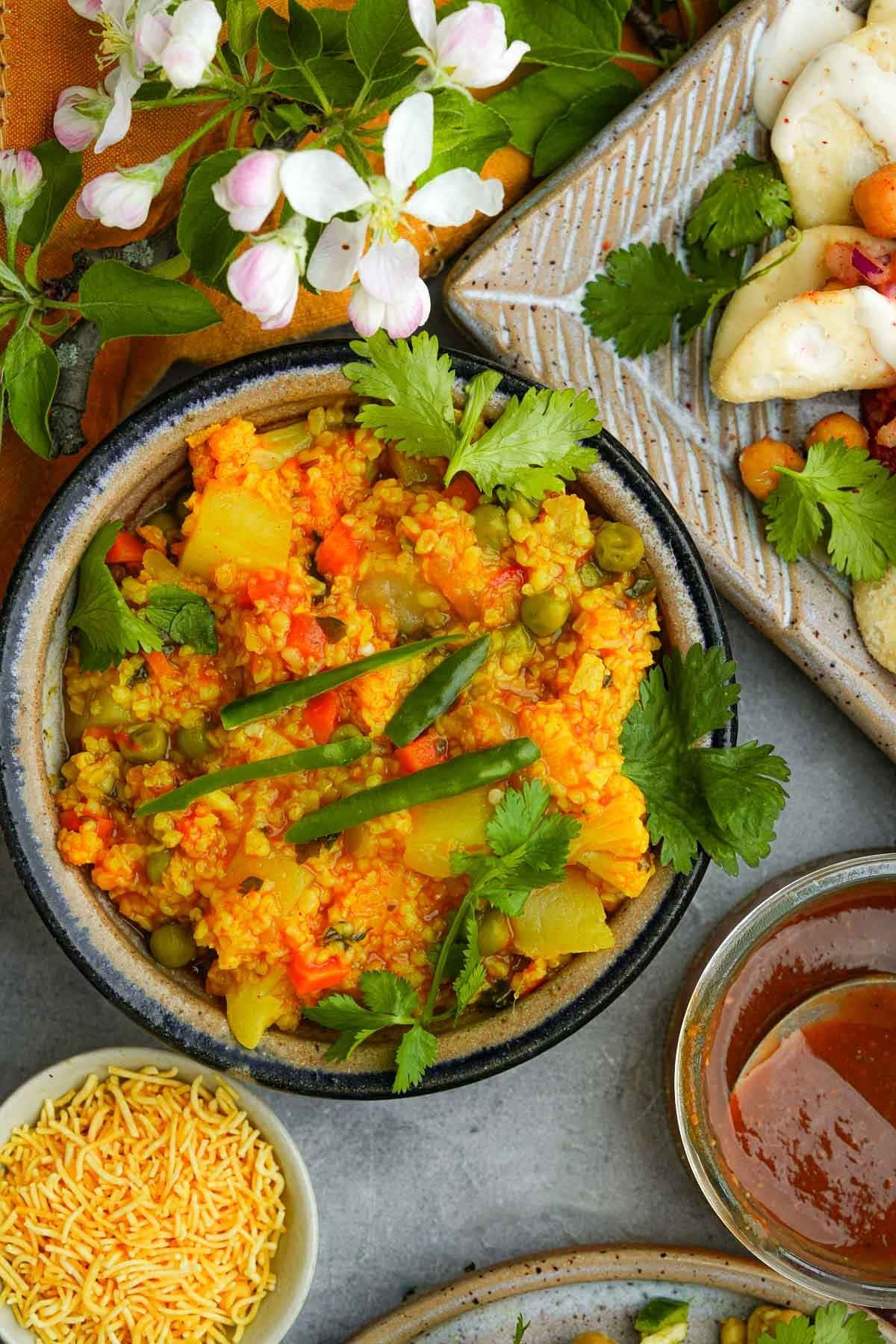
👉Top tips
- Opt for Consistent Cutting: This might seem obvious to you if you are a seasoned cook, but to ensure even cooking, chop all your vegetables (especially the carrots and potatoes) into as uniform sizes as possible. Smaller, consistent cuts not only cook more uniformly but also make it so every bite has a little bit of each veggie in it.
- Rinse Your Bulgur: Before adding the daliya (bulgur) to your pot, rinse it well in a very fine mesh strainer under cold water until the water runs clear. This removes any dust and excess starch from the grains. This helps them to maintain individuality instead of clumping when cooked.
- Simmer Slowly: Be patient, and don’t rush the cooking process! A slow simmer helps ensure the bulgur and all veggies are perfectly cooked.
- Adjust Seasonings at the End: After your Daliya has finished cooking, taste it and adjust the salt and seasonings. You may want to add a little water if it's gotten thicker than you like. You do you, as they say!
🤷♀️ Recipe FAQs
No, Daliya is made from bulgur, which is a form of wheat, and therefore contains gluten. If you need a gluten-free alternative, consider making a rice dish like nasi minyak, turmeric rice, or Indonesian coconut rice instead!
To boost the flavor of your Daliya, use vegetable broth (I have a primer about making it in my seitan recipe, which you can follow and use to make vegan butter chicken to serve with this) instead of water for cooking the bulgur and vegetables. You can also increase the amount of spices, add fresh herbs like cilantro, mint, or parsley before serving.
Daliya is best served hot as a main course or as a side dish. It pairs well with tamarind chutney, a side of onion bhaji, medhu vadai, or a fresh salad like urap sayur for a complete meal.
🥶Refrigerating Daliya:
To keep your Daliya fresh, store it in an airtight container, and place it in the refrigerator. It will stay good for up to five days. Make sure the container is sealed well to maintain the flavors and freshness.
❄️Freezing Daliya:
For longer storage, Daliya can be frozen. After letting it cool to room temperature first, portion the daliya into airtight containers, each with as much as you might want to thaw for a meal in the future. The frozen portions will be good for up to three months.
🌡️Thawing Frozen Daliya:
When you're ready to enjoy your frozen Daliya, transfer it from the freezer to the refrigerator to thaw overnight. This slow thawing process helps maintain the dish’s quality, without exposing it to unsafe temporaries where bacteria can develop.
🔥 Stovetop Reheating:
To reheat Daliya on the stovetop, place it in a saucepan over medium heat. Add a splash of water or vegetable broth to prevent it from drying out and to help redistribute the moisture evenly. Stir occasionally and allow it to heat through for about five to seven minutes until it's piping hot.
⚡ Microwave Reheating:
For quick reheating method, place the Daliya in a microwave-safe dish. Sprinkle some water over it to keep it moist. Cover with a microwave-safe lid or a plate to trap steam. Heat on high for one to two minutes, stir, and then continue heating in thirty-second bursts until thoroughly warm.
✨Don’t forget to garnish:
When reheating leftovers, I always like to garnish them with some fresh herbs and chilies to freshen it up and make it look attractive and lovely all over again.
✌️My faves to serve with bulgur khichdi:

Daliya (Vegan Bulgur Khichdi)
Equipment
Ingredients
- 4 teaspoons canola oil vegetable oil, or sunflower oil
- ½ teaspoon cumin seeds
- ½ cup red onion small diced
- 2 cloves garlic minced
- 2 teaspoons ginger grated
- ½ teaspoon Kashmiri red chili powder
- ¼ teaspoon turmeric
- ½ teaspoon asafetida
- ½ cup tomatoes diced
- 2 hari mirch green chilies minced (or 2 teaspoons minced jalapeño)
- 1 cup carrot peeled and diced
- 1 medium russet potato peeled and 1 cm. diced
- ½ cup green peas fresh or frozen
- ½ cup daliya coarse bulgur
- 1 teaspoon lime juice
- 2 ½ cups water
- 1 cup cauliflower small florets
- ⅓ cup cilantro chopped
- ¾ teaspoon salt or to taste
To garnish:
- Cilantro leaves
- Green chilies slivered
Instructions
- Heat the oil in a small Dutch oven or large saucepan over medium heat. After 90 seconds, when the oil is hot, add the cumin seeds and let them sizzle for about 30 seconds until they start to pop.
- Add the diced red onion to the pan and sauté until the onions are translucent and slightly golden, about three to four minutes. Stir in the minced garlic and grated ginger, cooking for another minute until fragrant.
- Sprinkle the Kashmiri red chili powder, turmeric, asafetida, and diced tomatoes and minced green chilies in the pan. Sauté until the tomatoes begin to break down and become saucy, about three to five minutes.
- Stir in the diced carrots and diced potatoes, peas, daliya (coarse bulgur).
- Pour in the water and bring the mixture to a boil. Once boiling, reduce the heat to low-medium and cover the pan. Let it simmer gently until the vegetables and daliya are tender, which should take about 25 minutes.
- Halfway through the cooking, add the cauliflower florets to the pan. Continue to simmer until everything is cooked through and the water has been absorbed.
- Stir in the lime juice, chopped cilantro, and salt to taste. Adjust the seasoning as needed.
- Serve hot, optionally garnished with cilantro leaves, and slivered green chilies.
Notes

Enter your email & I'll send it to your inbox. Plus, get great new recipes from me every week!
By submitting this form, you consent to receive emails from Cinnamon Snail.

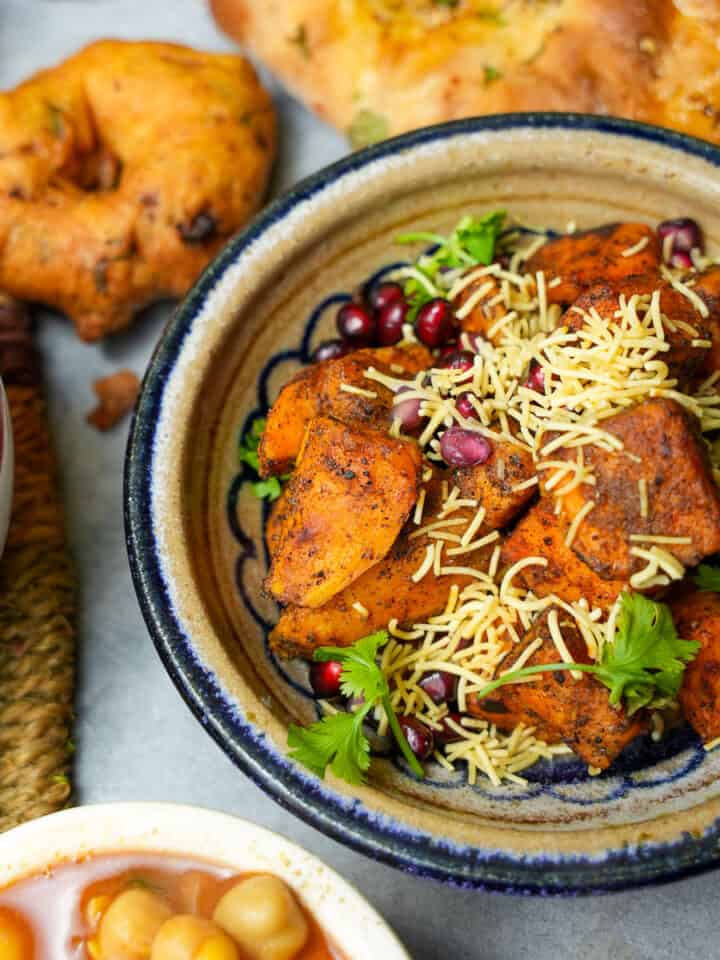

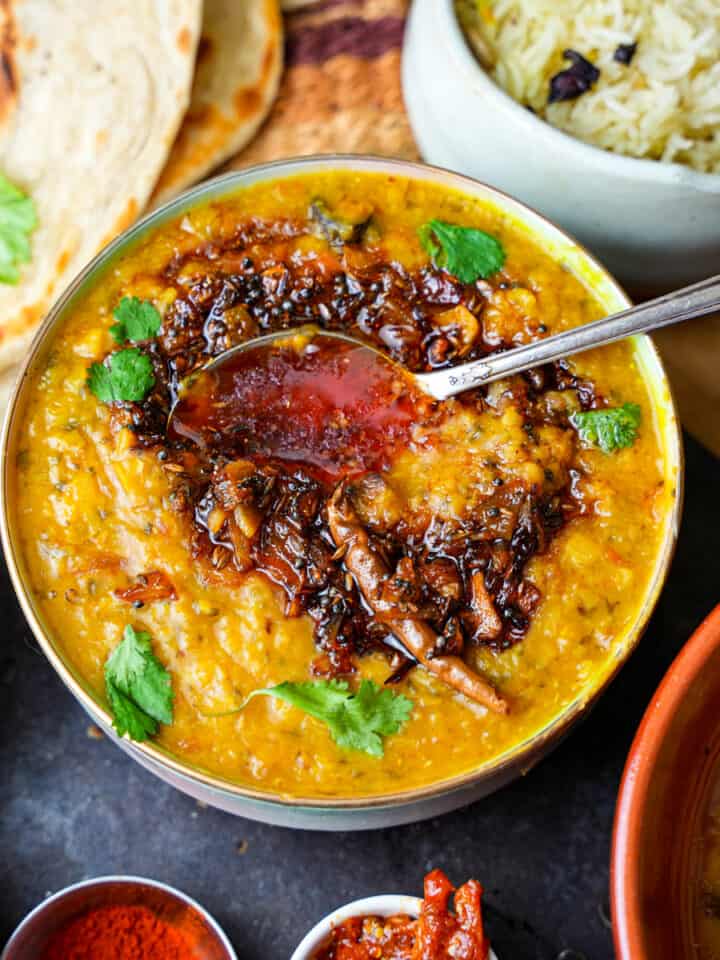
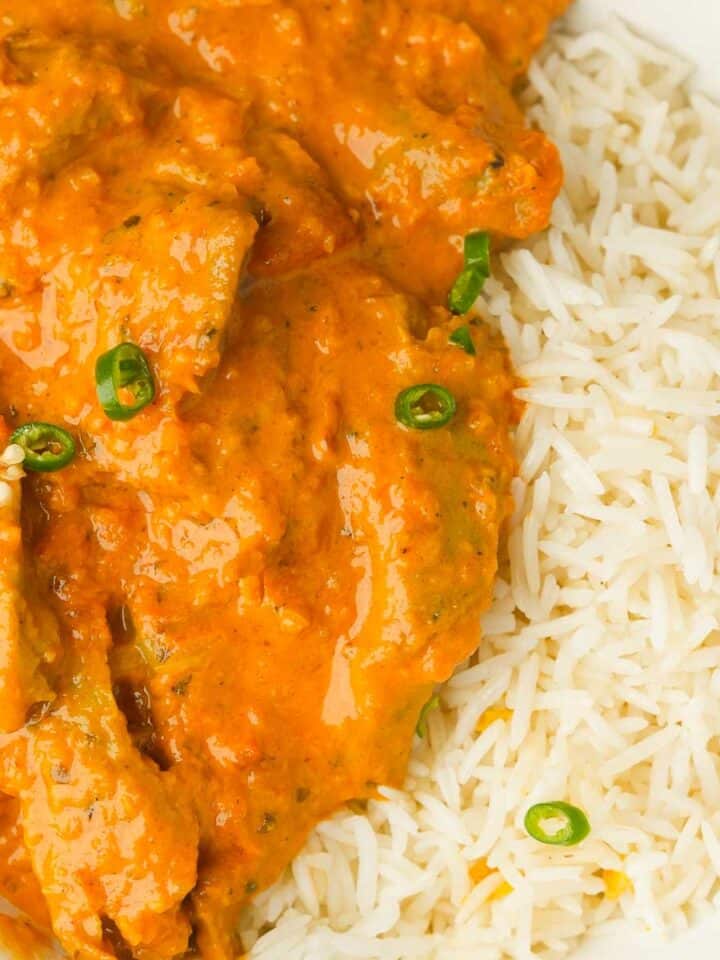





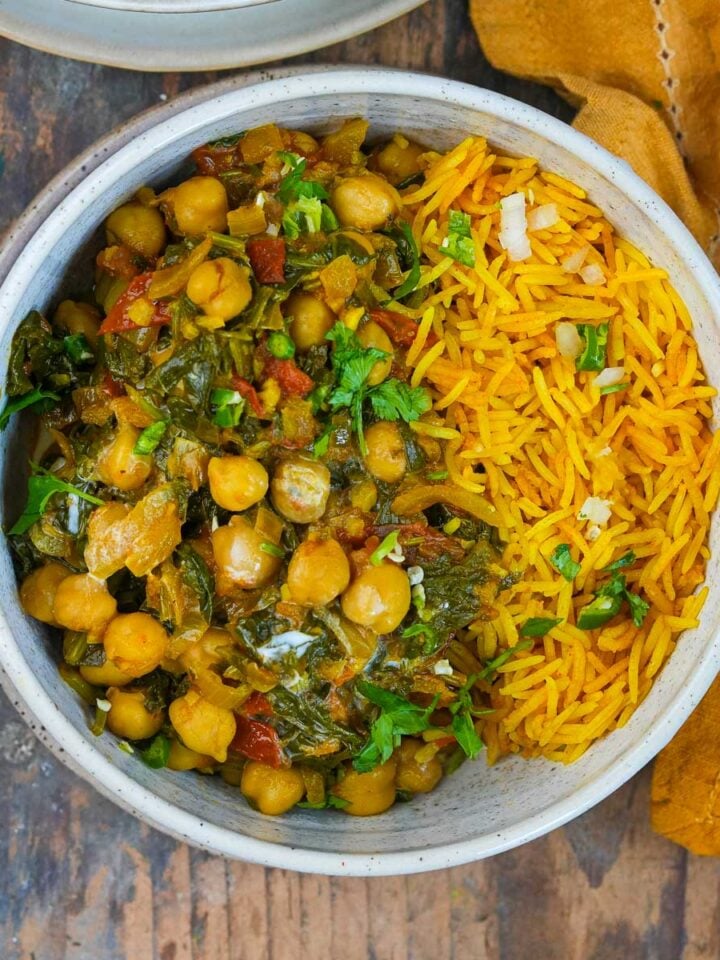
Liz says
Hi, Adam. I'm going to a potluck dinner and would like to take a side dish that can be served at room temperature. I know you said this is best served hot, but what are you thoughts on serving it at room temperature? It looks like it will really wow the crowd! Thanks as always.
Adam Sobel says
you can 100% serve this at room temperature. Another bulgur dish that is fantastic at room temp is this kisir.
hg says
Im so used to using bulgur wheat in a Turkish or Middle Eastern kinda way. This adds a new twist by introducing and Indian flavor profile. Loved it.